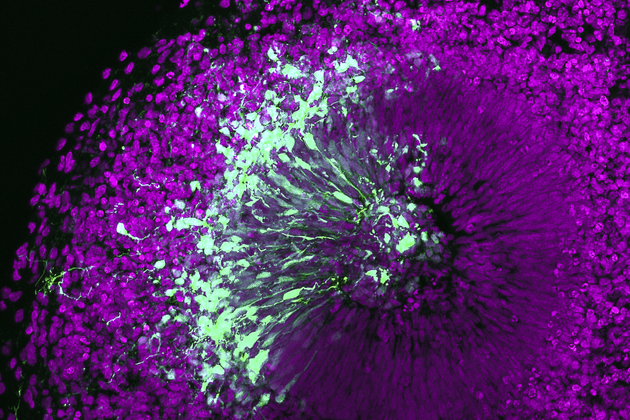Neurobiologists are certain that the neocortex is the defining factor that distinguishes humans. Rich in neurons, this outer layer of the brain enables humans to speak complicated languages, think abstractly, and produce art.
 A microscopy image of a human brain organoid. Image Credit: TUD Dresden University of Technology
A microscopy image of a human brain organoid. Image Credit: TUD Dresden University of Technology
An international team from TUD Dresden University of Technology's Center for Regenerative Therapies Dresden (CRTD), under the direction of Dr. Mareike Albert, has discovered a novel component that may have had a role in human neocortex expansion. The research was published in the EMBO Journal.
The distinctively folded outer layer of the brain with a walnut-like appearance is called the neocortex. Higher-order cognitive processes like language, art, and abstract thought are attributed to it.
The neocortex is the most recently evolved part of the brain, and all mammals have a neocortex, but it varies in size and complexity. Human and primate neocortices have folds while, for example, mice have a completely smooth neocortex, without any creases.”
Dr. Mareike Albert, Research Group Leader, Center for Regenerative Therapies Dresden
The neocortex's surface area is increased by the folds that are unique to the human brain. There are more neurons in the human neocortex, which supports sophisticated cognitive processes.
The molecular mechanisms driving neocortex evolution are still largely unknown.
Which genes are responsible for inter-species differences in neocortex size? What factors have contributed to brain expansion in humans? Answering these questions is crucial to understanding human brain development and potentially addressing mental health disorders.”
Dr. Mareike Albert, Research Group Leader, Center for Regenerative Therapies Dresden
The Power of Brain Organoids
The Albert group studied the developing brains of mice and humans to find factors controlling brain enlargement.
Dr. Mareike Albert said, “Stem cells in mice do not divide as much and do not produce as many neurons compared to primates. Humans, on the other hand, have a large number of stem cells in the developing brain. This highly expanded pool of stem cells underlies the increase in several neurons and brain size.”
A component that is absent in mice but present in humans was discovered by the team. The team investigated whether the recently discovered factor could affect neocortex expansion using 3D cell culture technologies.
Dr. Albert explained, “Thanks to the research awarded with the Nobel prize in 2012, it is possible to turn any cell into a stem cell. Such a stem cell can then be transformed into a three-dimensional tissue that resembles an organ, e.g., a brain. Human stem cells make it possible to study development and diseases directly in human tissues.”
Although they may not look like brains to the untrained eye, these 3D brain cultures, also known as brain organoids, closely imitate the molecular complexity of growing brains.
Dr. Albert explained, “Most of the cell types of the developing brain are present. They interact, signal, and are similarly arranged as in an actual human brain.”
The team was able to demonstrate that a growth factor called epiregulin does encourage the division and development of stem cells in the developing brain by using 3D brain organoids.
All About the Amount
Knowing that epiregulin drives expansion of human neocortical stem cells, we looked back at the gene that codes for epiregulin and tried to trace it through the evolutionary tree, the gene is not unique to humans, but also present in other primates and even in mice. Epiregulin is not produced in the developing mouse brain, however, because the gene is permanently shut off and not being used. We were intrigued to understand whether there are any differences in how epiregulin works in humans and other primates.”
Paula Cubillos, Study Lead Author, Center for Regenerative Therapies Dresden
Once more, the researchers resorted to 3D culture technology. The researchers created gorilla brain organoids using gorilla stem cells.
Dr. Albert explained, “Gorillas are endangered species. We know very little about their brain development. Organoids made from stem cells offer a way to study their brain development without interacting with the species at all.”
Upon comparing the impact of epiregulin on gorilla brain organoids and human brain organoids, the researchers discovered that incorporating epiregulin into gorilla brain organoids can also stimulate the growth of stem cells.
The effects of increasing the amount of epiregulin in human brain organoids were not observed. This could be the result of the human neocortex having already undergone significant expansion.
Dr. Albert concluded, “Unlike previously identified factors, epiregulin as such seems not to be unique to humans. Instead, the amount of the growth factor seems to be the crucial regulator for the inter-species differences.”
This work contributes to the growing understanding of what makes humans special while also emphasizing the value of emerging technologies as morally sound alternatives to animal experimentation.
Source:
Journal reference:
Cubillos, P., et al. (2024) The growth factor EPIREGULIN promotes basal progenitor cell proliferation in the developing neocortex. EMBO Journal. doi.org/10.1038/s44318-024-00068-7